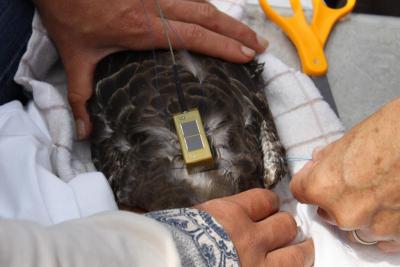Wareham Middle School takes flight with Great Shearwaters
Wareham Middle School students will be soaring with a new feathery friend this year: A Great Shearwater bird dubbed "WarehamMS".
The project takes off as collaboration between Stellwagen National Marine Sanctuary Research Coordinator David Wiley and Wareham Middle School teachers Jeff Eggers and Kristin Kelly.
Students will track WarehamMS via satellite a tag on the bird's back as it migrates from Cape Cod all the way to Tristan da Cunha in the middle of the South Atlantic Ocean.
Wiley, a Wareham native, has been tagging Shearwaters off of the coast of Cape Cod since 2013. He studies a variety of marine life including whales, plankton and other open ocean birds.
"We thought that a project like this would be a good way to get the public more involved with what we're studying," Wiley said. "We tagged a bird for each Middle School on Cape Cod and, of course, I wanted Wareham to be a part of that."
According to Wiley, a teacher at Chatam Middle School is constructing a Science Technology Education and Math (STEM) curriculum that all schools can use while tracking the birds. Under this curriculum, students will learn about the adaptations of open water birds, satellite technology and how different weather systems can affect migration patterns.
"We want to get them thinking like real scientists," Wiley said. "It's all about asking questions."
Participating schools will also compare their results throughout the year to see which bird goes the furtherest or flies the longest. The progress of each bird will be tracked on classroom maps and the Stelwagen website.
"We actually don't know a lot about the migration pattern of these birds," Wiley said. "So the kids will be making discoveries at the same time we are."
Great Shearwaters spend their summers feeding along the coast of Cape Cod and the Gulf of Maine from June to August. Come September, the birds migrate to the remote island of Tristan da Cunha which sits between South America and Africa.
"The birds we tagged are juvenile, so they'll migrate closer to November," Wiley explained. "But it's not a straight shot to the island, and what we're trying to figure out is where they feed along the way."
According to Wiley, the birds first travel from Cape Cod to Cape Verde. From there, they fly to Brazil and down the coast of South America all the way to the Patagonian Shelf.
"They spend their entire lives at sea and only come ashore to nest," Wiley said. "They're incredibly well adapted for life at sea."
The satellite tags on the birds' backs will send location signals 15 to 20 times a day.
"The life of the tags can be rather limited for that reason," Wiley said. "But there's going to be a lot of data for us and the kids to map out."
Wiley said he's excited to visit Wareham Middle School and talk to students about their findings.
"I think they're going to have some great questions," Wiley said. "As a scientist, you can get stuck in a certain way of thinking. New minds are always a welcome addition."
Members of the public who are interested in the project can following along with @trackseabirds on Twitter. A satellite tracking map can also be found online at www.seaturtle.org/tracking by clicking on the Stellwagen Shearwater Tagging 2018 link.














